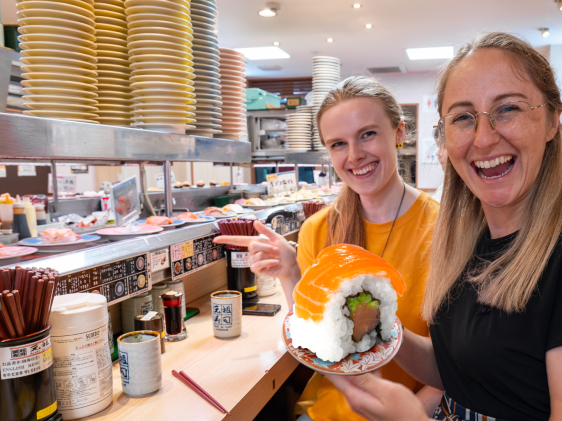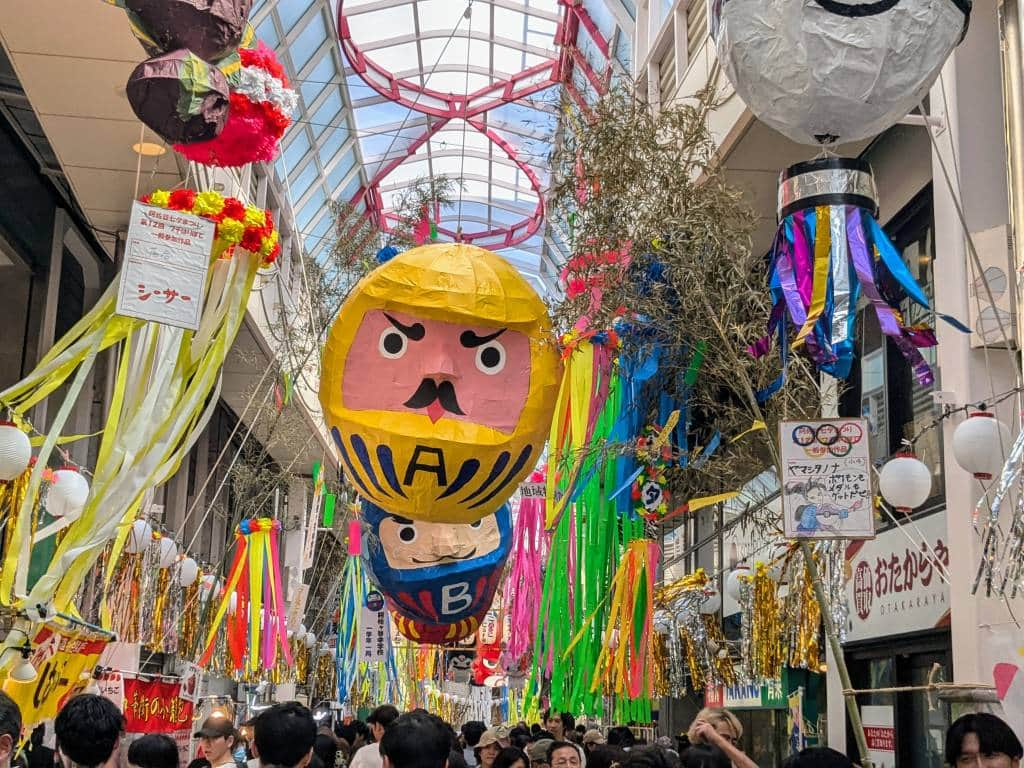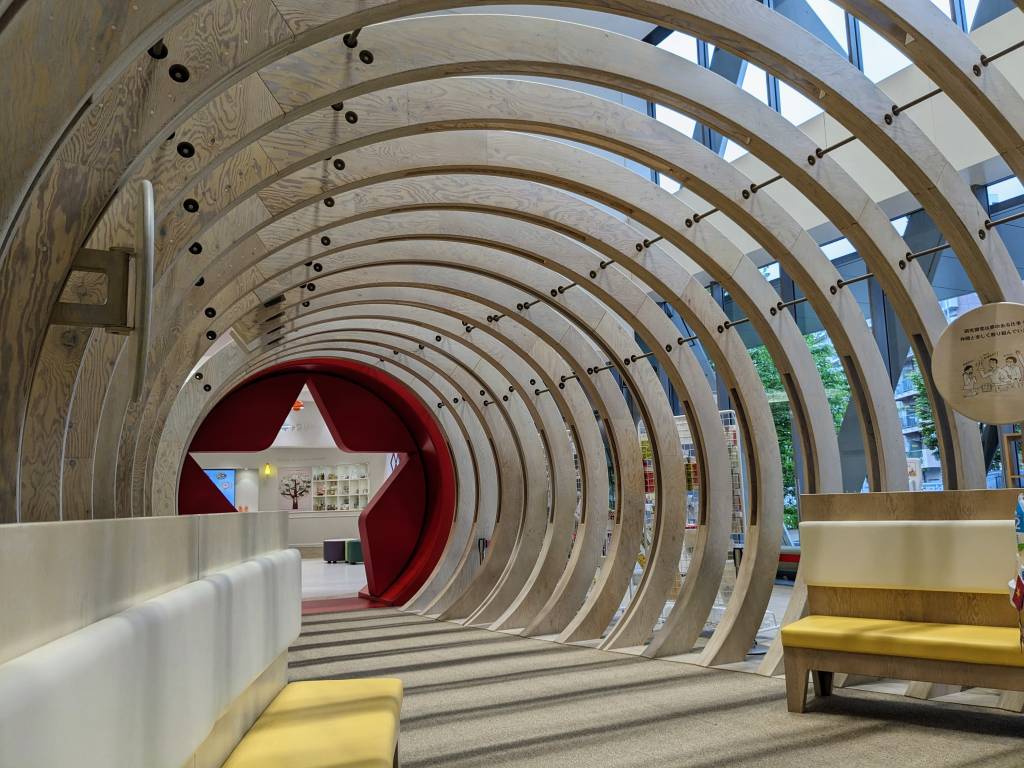If you happen to be hanging around Hamamatsuchō Station (JR Yamanote, Keihin-Tohoku lines) on a summer Friday evening, you will notice a hurried stream of outdoor types bearing backpacks, fishing gear, styrofoam ice chests, surf boards, and foldable kayaks. Heading briskly and intently toward Takeshiba Pier, the weekend warrior crowd clearly looks eager (even desperate) to escape. And once they board the overnight ferry, they will escape the city, without actually leaving Tokyo.
You may have heard by now that Tokyo claims the Izu island chain (伊豆諸島) in the Philippine Sea–or you may have noticed all the semi-tropical posters in Tokyo’s JR stations. A few years back, the Tokai Kisen company, which dominates nearly all transport to the islands, launched a tourist campaign that misleadingly packaged the islands as the Izu Seven (a logo on the hats and polos of Tokai Kisen employees). In actuality, there are nine populated islands in the chain—spanning a distance of 358 kilometers—all within Tokyo’s administrative jurisdiction.
With the right expectations and strategies, these far-flung corners of the metropolis can be a cheapo’s holiday paradise.
With nine islands to choose from it’s not a bad idea to start small. Shikine-jima (式根島), the smallest of the populated islands, is only about 3 km across. The island’s 600 residents are outnumbered by tourists on the weekends of the brief summer high season (July 19 until August 31), but the island feels wonderfully uncrowded at other times. Visitors looking for a substitute for Hawaii, Okinawa, or Guam may be disappointed with the marked absence of resorts, swimming pools, and nightlife. Shikine-jima’s size, natural resources, and culture are better suited to small inns, guesthouses, camping, and eco-tourism.

Shikine-jima’s rocky beaches, tide pools, shady trails, and unusual ocean-side hot springs are a beautiful introduction to what the Izu islands have to offer city-weary Tokyo-ites willing to appreciate the islands for what they are: a facet of rural Japan, an escape from concrete confinement, and an extraordinary opportunity to spend a day or two or three being re-acquainted with what nature looks like when it is (mostly) left to its own devices.

The week or two in mid-July sandwiched between the end of the rainy season and the official opening of the island’s summer season is the best time to enjoy Shikine-jima before the crowds arrive. Although no one will rent you a beach parasol outside of the strictly regulated beach season, the sun is hot and the water is clear and cool. Of course, as one of the the more visited of the Izu islands, Shikine-jima couldn’t be called pristine, but you don’t have to look too hard to find a sea biscuit bubbling its way through a shallow, rocky tide pool, or a seagull calculating his next mouthful of the silvery school that just came flailing by. Turquoise, yellow, and rainbow-striped fish will swim about your ankles if you stand still in the rocky waters of Ishijirogawa beach. It is difficult to spend a lot of money beach-hopping, snorkeling, trekking, and onsen-soaking on Shikine-jima. Beyond the necessities of food, transportation, sunscreen, and enough shaved ice and beer to keep you cool as you explore, there is little to buy and all the natural attractions are free. Camping is also free.

The most expensive part of a cheap trip to Shikine-jima may be the transport to and from the island on one of the ferries operated by the Tokai Kisen company. If you have lots of time and aren’t particular about sleeping conditions, the cheapest way to get to Shikine-jima is the large overnight passenger ferry–which departs from Takeshiba Pier near Hamamatsuchō (JR Yamanote, Keihin-Tohoku Lines) at 10 or 11 pm in the evening and arrives on the island between 7 and 8 am the next morning. A ticket that offers you a reclining lounge chair or a futon-sized space on the floor will cost around 7,000 yen one-way in the summer. It is also possible to book more private rooms on the overnight ferries, but adding a bit of comfort and privacy to your overnight journey will very quickly rival the cost of the high-speed jetfoils which are about 7 to 8 hours faster than than the overnight ferries and leave early in the morning. A high-speed jetfoil ticket from Takeshiba to Shikinejima costs about 11,000 yen one way if purchased on the day of departure. Modest discounts for boat travel are available if you purchase on-line (Japanese only), or if you purchase two weeks or more ahead of time in person at the pier, over the phone (03-5472-9999), or through a travel agent such as JTB.
Once you have safely arrived on Shikine-jima, the cheapest form of transportation is on foot, and walking is a reasonable option given the size of the island. The most tourist-preferred method of transport is hired bicycle. Bicycles rent for as little as 800 yen a day-and as much as 2,000 yen–depending on power-assist features. You can also bring your own bicycle on the overnight or high-speed ferry (1,000 yen one way if the bike is in a bag).

If you are planning to camp during Golden Week, July, or August, you must make your up the hill west from the ferry port toward Oura Beach where the island’s high season campsite is perched on a steep hillside overlooking a bay encircled by dramatic volcanic rock formations. The 50 or so tent sites at Oura are well-spread out and many have stunning views of the bay. The campsite also offers plenty of BBQ grills for cooking, as well as decent toilet and shower facilities that it shares with beach-visitors who are staying elsewhere on the the island. No reservations are required, but if you would like to try to reserve you can call the Shikine-jima village office (04992-7-0004). A small hut at the campsite handles the management of the campsite and the sale and rental of a few pieces of equipment. While the campground is predictably busy on weekends at the peak of the summer season, when we visited mid-week, pre-season we discovered only one lonely tent.

Oura campsite hires out kayaks for exploring the coastline. Trails that meander through the undeveloped third of the island and up to Kanbiki Lookout Point are also within easy reach of Oura Beach, as is the lovely Nakanoura Beach–which operates a beach hut during the high season–but at other times can be cozily isolated. On a hot day in mid-July, we spent a late afternoon alone on Nakanoura.

The Oura Beach campground is closed in the off-season, when the Kamanoshita campsite on the southeastern shore of the island opens for campers. Smaller and less equipped than the Oura campsite, the flat, grassy Kamanoshita campsite is located conveniently with a short walking distance of town, Ishijirogawa Beach, and three of the island’s free open-air, ocean-front hot springs. If you are going to camp at either site, you are required register with the town office when you arrive. The relaxed Tourist Office at the port should be able to help you to do this.

If you are happy to cook your own meals but would rather sleep indoors, Villa Early Bird (Reservations: 0499207-0240) offers efficiency-studios that sleep two to eight people for around 7.000 yen per person/per night in August (and less during other months of the year). Because Shikine-jima draws so many price-sensitive university students, young couples, and retirees, it is also possible find a room with two meals and shared bath and toilet for around 7,000 yen/night. Cheaper no-meal options are also available. Rakuten Travel sometimes lists good deals on Shikine-jima’s guesthouses (minshuku). Given that tiny Shikine-jima’s tourist map marks no fewer than seven fishing points, catching your own dinner might be the cheapest way to feed yourself, if you are so inclined. You can rent the necessary equipment if you don’t have your own.

If fishing isn’t your game, several mini-supermarkets in the island’s one-traffic-light town will suffice for necessary provisions. Because most of Shikine-jima’s food is shipped in from elsewhere, the selection is narrow, and prices may be noticeably higher than they are in central Tokyo. On the other hand, a small bento will only set you back about 600 yen. (Bear in mind that prepared foods sell out early in the day.) If you weary of self-catering, one of the Chinese restaurants in town maintains generous all-day hours, even in the pre-season, serving up simple rice and noodle dishes and shaved ice. Nothing on the menu is more than 900 yen.

Two or three days on Shikine-jima are a fraction of what it costs to fly to a more “exotic” island to park on a lounge chair around a chlorinated pool. I would also vouch for it being the more valuable of the two experiences. What’s more, if you like Shikine-jima’s outdoor holiday style, its Izu island neighbors–Nii-jima and Kōzu-shima–also offer well-maintained free campgrounds, clean beaches, open-air hot springs, trails, and peaceful quiet.



Information is subject to change.































